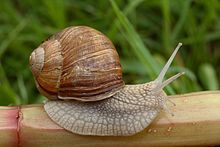Helix (gastropod)
|
Helix Temporal range: Oligocene–Recent |
|
|---|---|
 |
|
| Helix pomatia | |
| Scientific classification | |
| Kingdom: | Animalia |
| Phylum: | Mollusca |
| Class: | Gastropoda |
| (unranked): |
clade Heterobranchia clade Euthyneura |
| Superfamily: | Helicoidea |
| Family: | Helicidae |
| Genus: |
Helix Linnaeus, 1758 |
| Type species | |
|
Helix pomatia Linnaeus, 1758 |
|
| Species | |
|
See text |
|
| Synonyms | |
clade Euthyneura
clade Panpulmonata
clade Eupulmonata
clade Stylommatophora
informal group Sigmurethra
See text
Helix is a genus of large air-breathing land snails, terrestrial pulmonate gastropod molluscs.
This genus is native to Europe and the regions around the Mediterranean Sea.
Helix is the type genus of the family Helicidae.
The best-known species include Helix aspersa, the common, or brown garden snail, and Helix pomatia, the Roman snail, Burgundy snail, or edible snail. H. pomatia and some other species are eaten as escargots.
Helix snails have been introduced throughout the world, where some, especially H. aspersa, have become garden pests.
The genus Helix is known from the Oligocene on.
Snails in this genus create and use love darts during mating.
Subgenera and species within the genus Helix include today:
Subgenus Helix
Subgenus Pelasga
Subgenus Cornu
Subgenus ?
Some taxonomists remove the species "Helix aperta", "Helix aspersa", and "Helix mazzullii" from the genus Helix and place them in their own monotypic genera as Cantareus apertus, Cornu aspersum and Cantareus mazzullii.
...
Wikipedia
